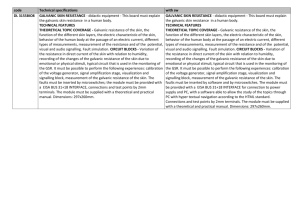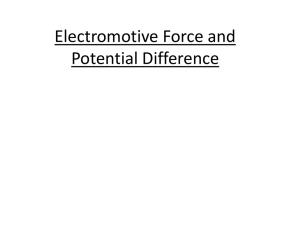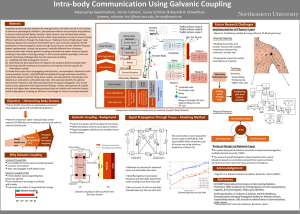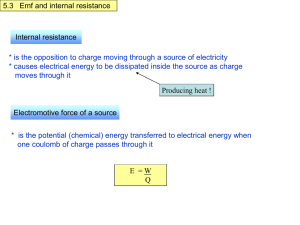Redox II - Electrochemistry
advertisement
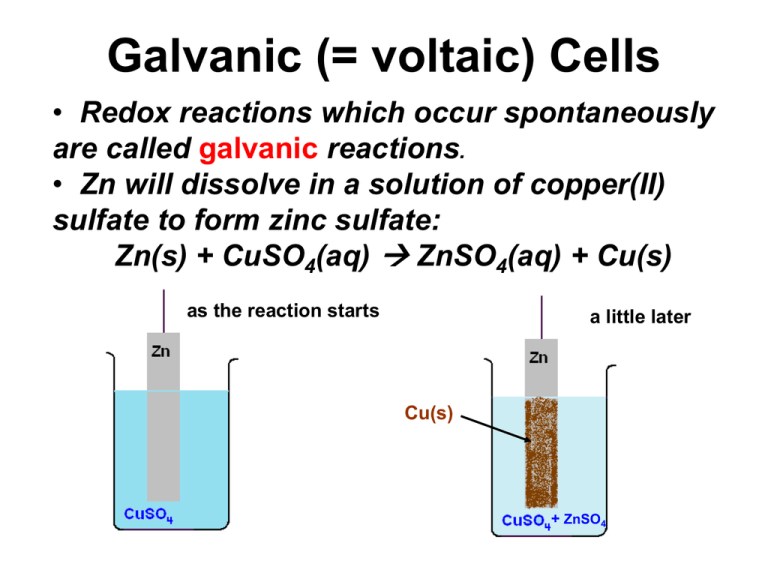
Galvanic (= voltaic) Cells • Redox reactions which occur spontaneously are called galvanic reactions. • Zn will dissolve in a solution of copper(II) sulfate to form zinc sulfate: Zn(s) + CuSO4(aq) ZnSO4(aq) + Cu(s) as the reaction starts a little later Cu(s) + ZnSO4 Galvanic Cells To take the energy from a galvanic reaction and get useful work from it requires setting up a galvanic (voltaic) cell. A salt bridge connects the two solutions of electrolytes and allows ions to move. Electrodes are conductors used to establish electrical contact with a nonmetallic part of a circuit. Galvanic Cells Oxidation occurs at the anode. In a galvanic cell, electrons flow spontaneously through the external circuit to the cathode. Reduction occurs at the cathode. Ion movement allows the circuit to be completed. Galvanic Cells What happens if the external circuit is removed? What happens if the porous barrier is removed? The useful work from a galvanic cell comes from the electric current flowing in the external circuit. This current can be used a source of electric power (for example, a battery is a source of electric power). Galvanic Cells Can the external circuit be removed? What happens if the salt bridge (electrolyte) is removed? If the water is removed, there are no means for the ions to move and corrosion will stop. Corrosion is a galvanic process. Removing one of the essential components of a corrosion cell can stop the corrosion process (usually a desirable thing). Galvanic Cells – Cell EMF • Given the equation for a redox reaction, how do we determine if it is galvanic (how do we know it will proceed spontaneously)? • There is a potential difference E (measured in volts) between the two electrodes of a redox cell. What is a volt? Moving a charge of +1 coulomb (C) through a potential difference of 1 volt requires 1 joule of energy: 1V = 1J/C • This potential difference is called the electromotive force (emf) of a cell and is symbolized Ecell. It is also called the cell potential. • When the cell potential Ecell is positive, the reaction will be spontaneous. Ecell is an Intensive Property 1V = 1J/C • This potential difference is called the electromotive force (emf) of a cell and is symbolized Ecell. It is also called the cell potential. • Because the cell potential Ecell is a ratio of energy to total charge, it is an intensive property. (This is different from ΔG.) Cell EMF • When the cell emf (cell potential) Ecell is positive, the reaction will be spontaneous. • Rather than tabulate all of the possible redox reactions and their emfs, we tabulate the emfs of the half-cell reactions in terms of their reduction potentials under standard conditions relative to the standard hydrogen electrode (SHE). This means “is defined to be.” • SHE: 2H+(aq,1M) + 2e- H2(g,1 bar) E°≡ 0V • Standard conditions are for a given temperature (often 25°C): all gases at 1 bar, aqueous species have an activity of 1 (which is approximately 1 M). Cell EMF • The emfs of the half-cell reactions are tabulated in terms of their reduction potentials under standard conditions. These standard conditions are denoted by the superscript: E°. • If the table is ordered in terms of reduction potential (increasing or decreasing), it is then called an electrochemical series. • The cell emf is calculated from the reduction potentials of the two half-reactions of the cell. Ecell = Ered(reduction half-reaction) – Ered(oxidation half-reaction) Cell EMF What is the emf when solid iron and the nitrate ion react under standard conditions at 25°C to form the ferrous ion and nitrogen monoxide gas? E°(cell) = 0.96 – (-0.44) = 1.40V unbalanced reaction: Fe(s) + NO3-(aq) Fe2+(aq) + NO(g) reduction half-rxn: NO3-(aq) + 4H+(aq) + 3e- NO(g) + 2H2O(l) E°(red half-rxn) = 0.96 V oxidation half-rxn: Fe(s) Fe2+(aq) + 2efrom the table, we have E°(Fe2+(aq) + 2e- Fe(s)) = -0.44 V Information from Reduction Potentials Reduction potentials can be used to determine • whether a reaction will proceed as written which leads you to the galvanic reaction • which of two species is more likely to be reduced (or oxidized) which leads you to the anode halfreaction which leads you to the cathode halfreaction • which of a group of species is the most reactive (size of the reduction potential) Reduction Potentials - Example You are told to set up a galvanic cell using a strip of iron, a strip of zinc, and 1M solutions of iron(II) nitrate and zinc nitrate at 25°C. 1. Which one of the metals will oxidize? Fe2+(aq) + 2e- Fe(s) Zn2+(aq) + 2e- Zn(s) E° = -0.44V E° = -0.76V A negative value for the standard reduction potential means the reduction is NOT favored. Zn has the more negative reduction potential, so it will oxidize. Reduction Potentials - Example You are told to set up a galvanic cell using a strip of iron, a strip of zinc, and 1M solutions of iron(II) nitrate and zinc nitrate at 25°C. 2. Determine what the two half-reactions will be. Red: Fe2+(aq) + 2e- Fe(s) Ox: Zn(s) Zn2+(aq) + 2e- Reduction Potentials - Example You are told to set up a galvanic cell using a strip of iron, a strip of zinc, and 1M solutions of iron(II) nitrate and zinc nitrate at 25°C. 3. Which half-reaction occurs at the anode? Oxidation occurs at the anode: Zn(s) Zn2+(aq) + 2e- Reduction Potentials - Example You are told to set up a galvanic cell using a strip of iron, a strip of zinc, and 1M solutions of iron(II) nitrate and zinc nitrate at 25°C. 4. What is the oxidizing agent? What is the reducing agent? The oxidizing agent gets reduced: Fe2+(aq) The reducing agent gets oxidized: Zn(s) Reduction Potentials - Example You are told to set up a galvanic cell using a strip of iron, a strip of zinc, and 1M solutions of iron(II) nitrate and zinc nitrate at 25°C. 5. What is the emf for the galvanic reaction under standard conditions? E°cell= -0.44 - (-0.76)=0.32V Cell reaction: Fe2+(aq) + Zn(s) Zn2+(aq)+ Fe(s) Reduction Potentials - Example You are told to set up a galvanic cell using a strip of iron, a strip of zinc, and 1M solutions of iron(II) nitrate and zinc nitrate at 25°C. 6. Why does plating zinc onto steel protect the steel from corrosion? Corrosion is oxidation. Zinc has a greater tendency to oxidize than iron, and will corrode instead of the steel (which is mainly iron). Zinc acts as a sacrificial anode. How does the activity series compare with the table of reduction potentials? Where in the table are the strongest oxidizing agents? Reducing agents? Reduction Potentials - Example Calculate the standard emf for the galvanic (voltaic) cell in which acidified permanganate ion reacts with the iron(II) ion to form the iron(III) ion and the manganese(II) ion. Write the balanced equation for the reaction. 1. Write and balance the two half-reactions: Fe2+(aq) Fe3+(aq) + e8H+(aq) + MnO4-(aq) + 5e- Mn2+(aq) +4H2O oxidation reduction 2. From the table of standard reduction potentials, we find E°(Fe3+(aq) + e- Fe2+(aq)) = 0.77V E°(8H+(aq) + MnO4-(aq) + 5e- Mn2+(aq) +4H2O) = 1.51V 3. E°cell = 1.51 – 0.77 = 0.74 V 4. The equation for the reaction is 5Fe2+(aq) + 8H+(aq) + MnO4-(aq) 5Fe3+(aq) + Mn2+(aq) +4H2O Note that the equation stoichiometry does not influence the cell emf. Gibbs Energy of an Electrochemical Cell The change in Gibbs Energy ΔG is the maximum non-PV work* that can be obtained from a chemical reaction at constant T and P: ΔG = wmax For an electrochemical cell, wmax = -nFE, n = number of electrons in reaction F = Faraday constant = 96500 J/V-mol E = cell EMF *or it is the minimum energy that must be supplied to make the reaction happen. Gibbs Energy of an Electrochemical Cell For an electrochemical cell, the maximum work that can be obtained from a chemical reaction at a temperature T is: ΔG = -nFE Under standard conditions, the relationship is ΔG° = -nFE° But we already know that ΔG = ΔG° + RT ln Q The Nernst Equation The equation for Gibbs energy can be written in terms of the emf of the electrochemical cell: ΔG = ΔG° + RT ln Q -nFE = -nFE° + RT ln Q Dividing by nF gives the Nernst E = E° - RT ln Q nF Equation: The Nernst Equation The Nernst equation lets us find the emf of an electrochemical cell under nonstandard conditions. E = E° - RT ln Q nF At 25°C, the Nernst equation may be note the change written from ln to log E = E° - 0.0592 V log Q n The Nernst Equation - Example E = E° - 0.0592 V log Q n What is the emf of the following cell at 298 K when [Ni2+] = 3.00 M and [Zn2+] = 0.100 M? Zn(s) + Ni2+(aq) Zn2+(aq) + Ni(s) Q = [Zn2+] [Ni2+] = 0.0333 M E = 0.48 - 0.0592 log .0333 = 0.48 + 0.0437 = 0.52V 2
